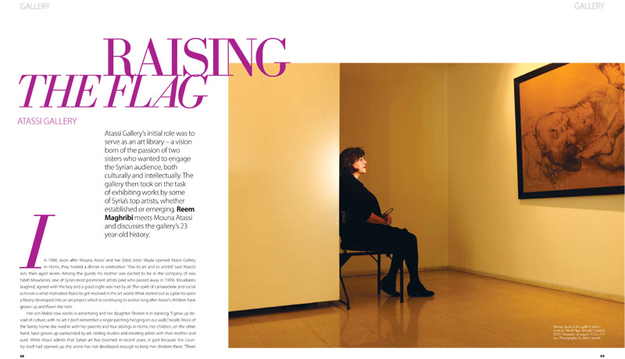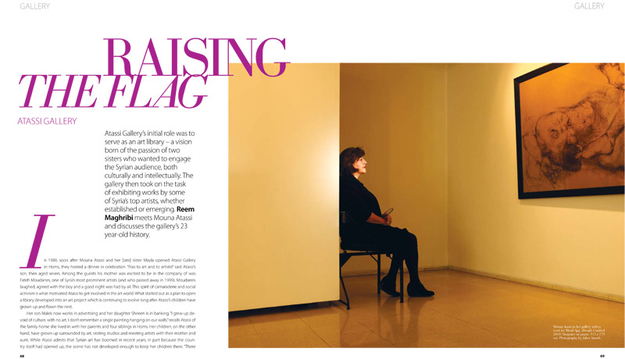In 1988, soon after Mouna Atassi and her [late] sister Mayla opened Atassi Gallery in Homs, they hosted a dinner in celebration. “Poo to art and to artists!” said Atassi’s son, then aged seven. Among the guests his mother was excited to be in the company of was Fateh Moudarres, one of Syria’s most prominent artists (and who passed away in 1999). Moudarres laughed, agreed with the boy and a good night was had by all. This spirit of camaraderie and social activism is what motivated Atassi to get involved in the art world. What started out as a plan to open a library developed into an art project which is continuing to evolve long after Atassi’s children have grown up and flown the nest.
Her son Malek now works in advertising and her daughter Shireen is in banking. “I grew up devoid of culture, with no art. I don’t remember a single painting hanging on our walls,” recalls Atassi of the family home she lived in with her parents and four siblings in Homs. Her children, on the other hand, have grown up surrounded by art, visiting studios and meeting artists with their mother and aunt. While Atassi admits that Syrian art has boomed in recent years, in part because the country itself had opened up, the scene has not developed enough to keep her children there. “There just aren’t enough opportunities,” she explains; “Those who work hard to educate themselves do not find enough openings in Syria.” Atassi herself, who married in 1970 without a university degree, worked hard as a young mother to study for and complete a degree in French Literature. “My children were young, so I registered at the University of Aleppo but only attended for exams. I graduated in 1984 and four years later opened the gallery.”
MAKING THE LEAP
The Atassi Gallery in Homs started out as a library. The sisters began to gather books which they wanted their fellow Syrians to read. Atassi herself had been immersed in the cultural world for a long time, meeting as many poets, literary figures, artists and filmmakers as she could. However, it became apparent, as they were sourcing the materials for the library, that their primary interest was in art and so a gallery with a comprehensive art library was born. It was no small feat for two women to open and run a gallery in Homs in the 1980s and they financed the project themselves, not expecting to make a profit. “Art is a cultural endeavour, not a business,” maintains Atassi, “and this was never a financial project. It is one of love and passion. Too much art today is about egos. Big canvases for big prices.” Meanwhile the recent boom in the Middle Eastern art scene means that the gallery, with its handful of staff, now pays for itself. Atassi puts its success and longevity down to a true passion for the work and for constant family support. “My husband was very supportive and remains one of my best clients,” she says.
A combination of family circumstances and a desire to take her gallery to the capital brought Atassi to Damascus, where she opened a gallery in 1993. Mayla moved to Dubai and, in 1995, opened the celebrated Green Art Gallery with Amna Dabbagh; since Mayla’s death in 2008, the gallery has been taken over by her daughter Yasmin and has relocated to Al-Quoz from its original space in Jumeirah. The distance and unique space and vision each gallery provides meant they complemented each other across the Peninsular divide, creating a unique platform through which a number of Syrian artists have become popular in Dubai and elsewhere in the Gulf. Atassi credits a growing interest in collecting from the Gulf as among the factors that have helped cultivate an increased number of Syrian artists and greater public awareness of them. Syria itself, believes Atassi, does not have a strong culture of collecting; she also feels that a sustainable art market in the country is still in its nascent stages. “We used to rely on the Lebanese in the early days. They have a history and tradition of art and have enjoyed many galleries since the 1960s, when Syria had only one or two, and those ended up being shut down,” she explains; “Syria was a closed society with bigger issues to contend with than collecting art.” Atassi acknowledges that Syria has since opened up, yet it is not her main exhibiting focus. “We have showcased our artists’ work in Lebanon, the UAE, France, Egypt and Jordan,” she says. While the Damascus gallery acts as a crucible, it is not the main stage. “The Gulf is definitely where the Arab art scene is now,” believes Atassi; “We don’t have to take the work to Europe, as European collectors now come to the Gulf where they can find many Syrian artists in exhibitions and auctions.”
THE ART OF SUSTAINABILITY
One of the first artists Atassi worked with is still one of her favourites: Moudarres, who not only influenced her appreciation of art but also her personality and outlook. “He was a great man. A rare breed,” she smiles. The gallery published an archive of Moudarres’s work before his death and another afterwards (Fateh Moudarres, 2004, in French/Arabic, in collaboration with the Institut du Monde Arabe, and the 2009 Fateh and Adonis - Dialogue in Arabic). “His work used to sell well, but he still led a modest life,” says Atassi. The days of extravagance in art, witnessed in recent years, make Atassi uneasy. “Exhibitions and auctions have helped raise the profile of Arab artists internationally, as have the number of galleries representing regional artists, but there is a downside to such activity,” she explains. Atassi’s concern is that art has become over-commercialised and that too few of today’s artists have real skill and passion. Her appreciation for the region’s cultural input in general is scant. “The Arab world is known predominantly for its contribution of Islam, medicine, astrology and mathematics,” she says; “There has, however, not been a technological or [major] media revolution.” What of the European artists who became enamoured with the Orient? “They came and took their subject matter, but that is where it ends,” she says. “We have strong artists, but we do not have a strong art movement; we present local subjects, but we use Western tools.”
Meanwhile, some commentators have claimed that Contemporary Syrian artists are producing better work than the older generation. Moudarres was a great artist, as were many of his peers,” Atassi replies. “Many Contemporary artists pursue art for fame and don’t realise that there can be more beauty and meaning in a small canvas than a big one. If there is no meaning, no message in the painting, it’s not art.” Time, Atassi says, is the real test of an artwork. What sells for high prices in boom-time can only truly be valued in the future. “Selling and art are two separate things,” she says, noting that stardom has become a new factor influencing the cost of artworks. But, as has always been the case with art, “pieces that matter, that contribute something, will remain valuable.” Her reverence for the older generation of artists stems from their role and activism in society. “[In those days] an artist was involved in society and his work reflected the issues of the day. The artists were the country’s intellectuals, with personal stories; they were more than artists,” she says. “Now stardom and egotism have taken over and this is a universal problem.”
“Organisations, museums, galleries, critics, schools... these all create a system of checks and balances that prevent the problem of hyperstardom affecting the art scene in a larger sense,” continues Atassi; “[That way] there is a foundation on which a strong art scene is based.” A lack of genuine art critics, with the cultural understanding and freedom of speech required for such an endeavour, is missing in Syria’s art scene. “There are not enough magazines and galleries. There can be no critique without critics and no criticism without freedom of expression. These factors and others contribute to a sustainable art market,” affirms Atassi. The fact that the reality is that all of Syria’s cultural undertakings and events are presented in cooperation with its Ministry of Culture is a clear indication of governmental dominance of the scene.
CLOSING THE GAP
Time has proven the real test of the gallery and of Atassi’s resolve in the face of so many obstacles. “Syria had only began to open up to the outside world in the past decade. Before that was a real adventure, an ongoing struggle,” she says. The artists themselves toiled to make a living purely from art. “Now there are artists who can live off their works. Back then, they had a day job, such as teaching.” In the mid 1990s, video art, installations and even photography were absent in Syria’s art studios or exhibition spaces. In a bid to educate Syrian artists and the still-modest local market of art enthusiasts, Atassi also worked in cooperation with a number of cultural centres in Damascus to showcase new media works by foreign artists that were not yet popular in the country.
As far as representation goes, works by Syrian artists Youssef Abdelke, Sabhan Adam (Canvas 1.2), Ahmed Moualla (page 88), Monif Ajaj and photographer Fassih Keiso take pride of place at Atassi Gallery and were showcased during the gallery’s participation in Art Dubai. Atassi is also keen on exhibiting works by non-Syrian artists – this year she showed pieces by Sudanese artist Hassan Musa at the same fair. Young artists are also of great interest to the gallery – aside from receiving their portfolios regularly, Atassi visits art colleges and studios and selects works by emerging artists, as she believes that they add something new to the forum. What new endeavours is Atassi working on? “We have no upcoming projects,” she smiles. “Our next project is for freedom and democracy.”

